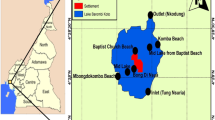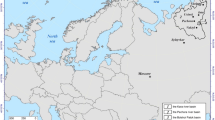Abstract
The northern end of Lake George, Uganda, and its associated wetlands receive localized metal pollution from a former copper mine and tailings left after metal extraction. The aim of this study was to determine (i) whether the heavy metals are a threat to the biology of the major commercial fish species and (ii) whether consumption of the fish threatens human health. Concentrations of copper, zinc, cobalt and nickel in detrital sediments, plankton, and five fish species from sites in Lake George, the Kazinga Channel and Lake Edward (which are inter-connected) were determined using atomic absorption spectroscopy. The detrital sediments of Hamukungu Bay, Lake George, had average concentrations (μg/g dry weight) of 96.3 zinc, 270.4 copper, 57.4 cobalt and 42.8 nickel. There were no significant differences between the Hamukungu Bay and the North Lake George site of Bushatu: both receive inflows from the mining activities. Concentrations of copper and zinc were significantly higher than background values from unpolluted freshwater ecosystems. Plankton samples showed a metal concentration gradient consistent with a gradient from the source of pollution in northern Lake George, along the Kazinga Channel to Lake Edward. The liver tissues of fish had markedly higher concentrations of copper and zinc than flesh. Concentrations of cobalt and nickel were relatively low. The highest mean concentrations of metals in liver tissue occurred in Oreochromis leucostictus (189.0 μg/g Cu) and Bagrus docmac (187.5 μg/g Zn) whilst the lowest occurred in Oreochromis niloticus (15.3 μg/g and 78.2 μg/g dry weight copper and zinc, respectively). However, O. niloticus contained the highest concentrations of cobalt (11.2 μg/g) and nickel (3.8 μg/g). Liver Somatic Indices (LSI) of the fish species from the different sites indicated a reduction of LSI in those fish from the most contaminated zones of northern Lake George compared with all other sites. This suggests there could be anatomical and physiological abnormalities linked to the heavy metal pollution. The flesh had only low concentrations of metals; well within international guidelines for consumption. A person would have to consume 9 kg of fresh flesh of Clarias sp. and 65 kg of O. leucostictus daily to exceed the WHO recommended intake for copper, and even more for other metals. This implies that currently metal pollution in Lake George presents an ecological rather than a human health concern.
Similar content being viewed by others
References
Bendell-Young, L. I., H. H. Harvey & J. F. Young, 1986. Accumulation of cadmium by White Suckers, Catastromus commersoni in relation to fish growth and lake acidification. Can J. Fish. aquat. Sci. 43: 806–811.
Berg, H., M. Kiibus & N. Kautsky, 1995. Heavy metals in tropical Lake Kariba, Zimbabwe. Wat. Air Soil Pollut. 83: 237–252.
Bugenyi, F. W. B., 1979. Copper ion distribution in the surface waters of Lake George and Idd Amin. Hydrobiologia 64: 9–15.
Bugenyi, F. W. B., 1982. Copper Pollution Studies in Lakes George and Edward, Uganda: The Distribution of Cu, Cd and Fe in the Water and Sediments. Environ. Pollut. Ser. B. 3: 129–138.
Busulwa, H. S. & F. W. R. Busenene, 1995. Assessment of copper pollution on the ecosystem of Queen Elizabeth National Park, Uganda. Unpublished Report, Uganda Institute of Ecology.
Chapman, D., 1992. Water Quality Assessments; a guide to the use of biota, sediments and water in environmental monitorng. Chapman & Hall, London: 90–95.
Denny P., 1987. Monitoring of Heavy Metals–A Proposed Strategy for Developing Countries. In Hutchinson T C & K. M. Meema (eds), Lead, Mercury, Cadmium and Arsenic in the Environment. SCOPE. John Wiley and Sons Ltd: 343–347.
Denny P., R. G. Bailey, E. Tukahirwa & P. Mafabi, 1995. Heavy metal contamination of Lake George (Uganda) and its Wetlands. Hydrobiologia 297: 229–239.
DEP, 1995. A handbook of Lake George wetlands and Ramsar site, Department of Environment Protection, Ministry of Natural Resources, Kampala, Uganda.
Driver, P. & E. Tukahirwa (eds), 1990. Preliminary Environmental Impact Assessment of Kasese Cobalt Plant Stock-piles, Western Uganda. IUCN Report. 41 pp.
Dunn, I. G., M. J. Burgis, G. G. Ganf, L. M. McGowan & A. B. Viner, 1969. Lake George, Uganda, A Limnological Survey Int. Ver. Theor. Angewand. Limnol. 17: 284–288.
Dunn, I. G., 1972. Ecological studies on the fish of Lake George, Uganda, with particular reference to the cichlid genus Haplochromis. Ph.D thesis, University of London, U.K.
Edroma, E. L., 1974. Copper pollution in Rwenzori National Park, Uganda J. Appl. Ecol. 11: 1043–1056.
EPA, 2001. Online series. Drinking Water and Health. Specific Fact Sheets for Consumer. http://www.epa.gov/OGWDW/dwh/cioc/ cop per.html.
Ewers, U. & H-W. Schlipkoter, 1991. Intake, Distribution and Excretion of Metals and Metal Compounds in Humans and Animals. In: Merian E. Metals and Their Compounds in the Environment; Occurrence, Analysis and Biological Relevance. VCH Weiheim: 571–583.
Flemming, C. A. & J. T. Trevers, 1989. Copper toxicity and Chemistry in the Environment: A Review. Wat. Air Soil Pollut. 44: 143–158.
Forstner, U. & G. T. W. Wittmann, 1981. Metal pollution in the aquatic Environment 2nd Edition. Springer-Verlag, Berlin.
Ganf, G. G., 1974a. Phytoplankton biomass and distribution in a shallow eutrophic lake (Lake George Uganda). Oecologia 16: 9–29
Ganf, G. G., 1974b. Diunal mixing and vertical distribution of phytoplankton in a shallow equatorial lake (Lake George, Uganda). J. Ecol. 62: 611–629.
Greenwood, P. H., 1976. Lake George, Uganda. Phil. Trans. R. Soc. Lond. B. 274: 375–391.
ILMP, 2001. Integrated Lake Management Project. Environmental Strategy for Lake George. ILM Working Paper #3.
Katswera, J., 1998. The Distribution and Abundance of Oreochromis niloticus and Oreochromis leucostictus in Lake George, Uganda. MSc. Thesis, Makerere University, Kampala.
Kelderman, P., W. M. E. Drossaert, Zhang Min, L. S. Galione, L. C. Okonkwo & I. A. Clarisse, 2000. Pollution assessment of the canal sediments in the city of Delft (The Netherlands). Wat. Res. 34: 936–944.
Kelly, M., 1988. Mining and the Freshwater Environment. Elsevier Applied Science. London. 231 pp.
Kieffer, F., 1991. Metals as Essential Trace Elements for Plants, Animals and Humans. In: Merian, E. (ed.), Metals and Their Compounds in the Environment; Occurrence, Analysis and Biological Relevance. VCH Weiheim: 481–489.
Mbeiza, N. M., 1993. Impact of copper mining complex on soils and some flora of Kahendero swamp of Lake George, Uganda. MSc. thesis, Makerere University, Kampala, Uganda.
Mckim, J. M. & D. A. Benoit, 1974. Duration of toxicity tests for establishing ‘no effect’ concentrations for copper with brook trout (Salvellinus fontinalis). J. Fish Res. Bd Can. 31: 449–452.
McMahon, J.W., J.M. Judd, A. E. Docherty & B. O'Donnell, 1985, The influence of water chemistry on the accumulation of stable cobalt by freshwater fish. In Lekkas, T. D. (ed.), Heavy Metals in the Environment International Conference, Athens. Sept. 1985 1: 258–262.
Moore, J. W. & S. Ramamoorth, 1984. Heavy metals in natural waters. Applied Monitoring and Impact assessment. Springer-Verlag, New York: 88–94.
Moriarty, D. J. W., J. P. E. C. Darlington, I. G. Dunn, C. M. Moriarty & M. P. Tevlin, 1973. Feeding and grazing in Lake George, Uganda. Proc. R. Soc. Lond. B 184: 299–319.
Morris, A.W., 1971. Trace metal variation in seawater of the Menai Straits caused by a bloom of Phaeocystis. In Forstner, U. & G. T. W. Wittmann (eds), Metal Pollution in the Aquatic Environment. 2nd Edition. Springer-Verlag. Berlin.
Muwanga, A., 1997. Environmental impacts of copper mining at Kilembe Uganda: a geochemical investigation of heavy metal pollution of drainage waters, stream sediments and soils in the Kilembe Valley in relation to mine waste disposal. Institutes für Geowissenschaften der Technischen Universität Braunschweiger. 140 pp.
Pratap, H. B., 1989. Use of tilapia as indicator of heavy metal pollution in East Africa; a study on cadmium exposure. In Khan M. R., & H. J. Gijzen (eds), Environmental Pollution and its Management in East Africa. Symposium Proceedings, Faculty of Science, University of Dar es Salaam. Sept.11–14 1989: 215–222.
Salomons, W. & U. Forstner, 1984. Metals in the hydrocycle. Springer-Verlag, Berlin: 25–36.
Samiullar, Y., 1990. Biological Monitoring of Environmental Contaminants: Animals. GEMS-monitoring and Assessment Research Centre, Kings College, London: 284 (767 pp).
Talling, J. F. & I. B. Talling, 1965. The chemical composion of African lake waters. Int. Rev. ges. Hydrobiol. 50: 412–463.
Viner, A. B., 1969. The chemistry of the water of Lake George, Uganda. Int. Ver; Theor. Angewand. Limnol. 17: 289–296.
Viner, A. B., 1971. Ecological Chemistry of a Tropical African Lake. PhD Thesis, University of London.
Wootton, R. J., 1981. Ecology of Teleost fishes; Fish and Fisheries Series 1. Chapman and Hall, London.
Young, B., 2000. Queen Elizabeth National Park, Kyambura Wildlife Reserve and Kigezi Game Reserve General management plan. Uganda Wildlife Authority.
Author information
Authors and Affiliations
Corresponding author
Rights and permissions
About this article
Cite this article
Swaibuh Lwanga, M., Kansiime, F., Denny, P. et al. Heavy metals in Lake George, Uganda, with relation to metal concentrations in tissues of common fish species. Hydrobiologia 499, 83–93 (2003). https://doi.org/10.1023/A:1026347703129
Issue Date:
DOI: https://doi.org/10.1023/A:1026347703129




